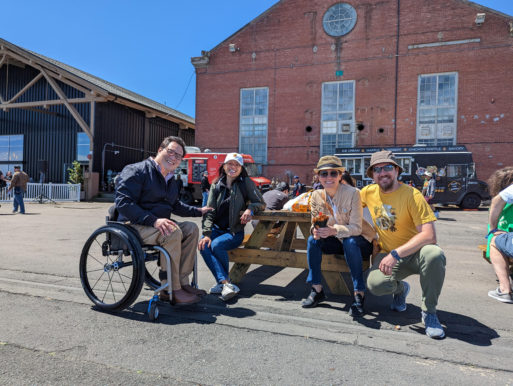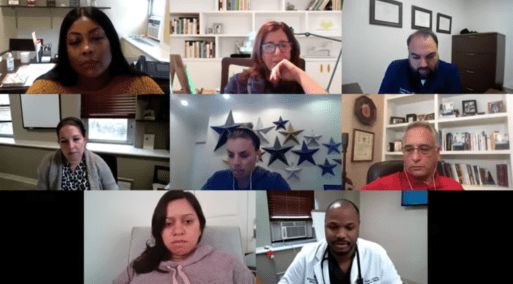
Hoa (left) enjoys lunch with friends.
Medical professionals cannot prevent death, but Hoa Le, M.D. is working to provide patients with what he describes as a “beautiful, dignified” end-of-life experience.
Le, who’s been an oncologist for the past 17 years and currently practices at Kaiser Permanente in Santa Clara, California, has created a new form of care that’s altering the late-stage cancer experience — not only for patients, but also practitioners. By holding weekly meetings, or “huddles,” between oncology physicians and palliative care physicians, Le has created a space for separate medical teams to unify and deliver a more attentive and supportive level of care to the patient. During such a momentous point in a person’s life this seemingly small adjustment can make a world of difference. SevenPonds had the privilege to sit down with Le and discuss his new care practice.
Editor’s Note: This interview has been edited for length and clarity.
What makes this combination of oncology and palliative care different from past dynamics?
In the past, we might walk by each other and talk for a couple minutes, or we might write each other a couple of messages. Even if we were to write each other a massive essay on what’s going on with a patient, that doesn’t allow for the nuanced discussion that you can have when you have protected time and you’re speaking live. We can get into the minutiae, which is still important, like family dynamics or where the patient’s mindset is at.
What do these meetings look like?
Our weekly meetings are called huddles, where we meet for about 30 minutes. The team is composed of an oncologist, palliative care physicians and a palliative care nursing lead. We incorporate a social worker when we can, an advanced practice provider, and then a nurse case manager. It’s a multi-disciplinary team with a lot of beautiful input and beautiful perspectives.
Can you speak a little more about how these huddles have been beneficial?
They allow us to support each other beautifully because these cases can be tough. We love our patients because we’ve taken care of them for a long time. We love them as people, and we should, in order to give them the best care. We’re people first. When it’s towards the end of their time, it can be really rough on all of us. Having this protected time to get together weekly and be present for this work has been priceless. We help each other through.
There are a lot of scenarios where you know badness is coming, but our patient is not ready for it. And they may not be ready until the 11th hour. How do we reconcile with that? Over time, I’ve actually become more comfortable with these scenarios by getting to know the mindset of our palliative care partners. I never expected to be comfortable with it, but I find myself evolving in this way.
 It’s like you’ve had to learn the skills of the palliative care experts?
It’s like you’ve had to learn the skills of the palliative care experts?
Yes, and vice versa. They’ll ask me questions about why I’m doing this or that. And I’ll tell them about the biology of the tumor. It’s like any other beautiful relationship. The huddles allow us to get to know each other and how each of us think and feel about a certain situation. We broaden each other’s worlds.
It seems this combination of the two teams helps out not only the patients but also the practitioners.
It helps us ultimately make the best decision for the patient. A lot of times, when we feel alone or uncomfortable in the decision-making, to be able to bounce these decisions off of a whole team is important.
Would you say that an oncologist would normally bring that kind of care and that kind of attention to detail without this partnership?
I think we would not. Without that kind of consistent interaction and care, absolutely it gets lost in our consciousness. So in this way, we become better practitioners and better people.
I would imagine that has a pretty big effect on the patient to have that heart and humanity aspect coming through in the care.
You bet. Too often we get caught up in ‘”Okay this is what you have, and this is the therapy and see you later.” And you’re right, it can lack that depth of human touch. But by having these great conversations, it’s awesome, in this protected venue where we’ve gotten to know each other and we feel safe to share whatever it is that needs to be shared.
Can you give some examples of how the team’s approach has made a difference in patient care?
Yes, a couple. One was a younger woman who had pretty advanced stomach cancer. We were aggressive with her therapy, and she did well and actually had a couple years in between when she was really well and the disease was quiet. So that made it difficult for her to accept when the disease came back. And we thought it would be impossible to bring up these end-of-life conversations with her, and surprisingly it was a lot less difficult because of this program. We could talk about our strategy for bringing this up to her. You know, she was Mexican and our nurse lead was Mexican, and she gave us insight into the cultural mindset. And so that helped us with our approach. So surprisingly, it wasn’t this difficult conversation. She accepted hospice care, at a pretty good time. She had what we call a good death. A beautiful, dignified transition.
We had another younger-ish man. He had metastatic pancreatic cancer. And — same thing — he did well for a long while, and so when things started to change, it was very difficult to accept. He was a holdout until the 11th hour. It’s difficult when we see this person is going to suffer when they should’ve been on hospice care weeks ago. But it was his wish. And we reminded each other, because of this program, because they were his wishes and we had to follow them. In the past, I would’ve beaten myself up, knowing his last few days and weeks were horrendous. But having the support of the team and reminding each other that we were honoring his wishes was very helpful.

Source: Burst
What made you want to start this type of care?
I’ll say that most of us didn’t have enough exposure in our training. Perhaps it’s better now, but I think it’s perhaps still not enough. I always felt the importance of having this conversation. Even if the patient is not ready to talk about it, that’s still important to know. I realized early on that if we don’t invest in this aspect of the relationship early on or throughout, it makes the end that much more difficult. If you don’t broach the topic of what happens when things start to progress, or what are your needs and wants out of all of this, at the end it can be impossible to talk about all of that. It’s the 11th hour and things are going terribly, and all of a sudden you urgently have to talk about it. But when you mesh this palliative care mentality early on, it makes the transition a lot less tough, even a lot more beautiful and dignified.
What differences have you noticed for patients under this program?
I feel like that terminal stage has become a lot smoother. They’re getting a lot better, less fragmented care. We can make sure we’re on the same page. And we can even tell the patient “Hey we talked about you just the other day.” And they appreciate that.
What types of obstacles do you run into that maybe you didn’t have before?
When we’re busy, there’s still not enough time. We might have a more robust conversation on one patient who has a lot of nuances to their care, and find we have less time than we thought. Or sometimes we let things drift because we’re not as busy, and we may get a little complacent. Maybe we didn’t add a certain patient to the list when we could have.
Do you see this program evolving in any particular way in the future?
This pilot program has just been for our GI cancer patients. But we’re thinking of expanding it to other diagnoses that have a high symptom burden and palliative care need. Or the next possible evolution is us leveraging group visits, even if it’s virtual, with us, the palliative care team, and the patient together.
If you could snap your fingers and make a sweeping change to the way things are done in your field, does anything come to mind?
I just wish we had more time. Even if a 20-minute consult could be a 40-minute consult, that would make a major difference. Let’s double the time for everything. If it’s our first meeting, give us two hours so we can get to know each other better. And then we can talk about the hard facts. It would go such a long way.
Is there anything else you’d like to add?
Yes, I started this program with Esther Luo, she’s the palliative care M.D. And then there’s Dulce Alcantara; she’s the director of the coordination of care. Then we often have Imelda Osana, our oncology social worker. We have our palliative care nurse Cara Danner. My colleague who does GI oncology James Chang. My PA Ji Eun Lee. My nurse case manager is Wossen Sadamo. We are a very cohesive team and I’m proud to work with all of them.

 A Virtual Team Huddle Brings More Humanity to Cancer Care
A Virtual Team Huddle Brings More Humanity to Cancer Care


 Recovering Cremation Remains After the Los Angeles Fires
Recovering Cremation Remains After the Los Angeles Fires
 “As Tears Go By” by Marianne Faithfull
“As Tears Go By” by Marianne Faithfull
 “The Sea” by John Banville
“The Sea” by John Banville














